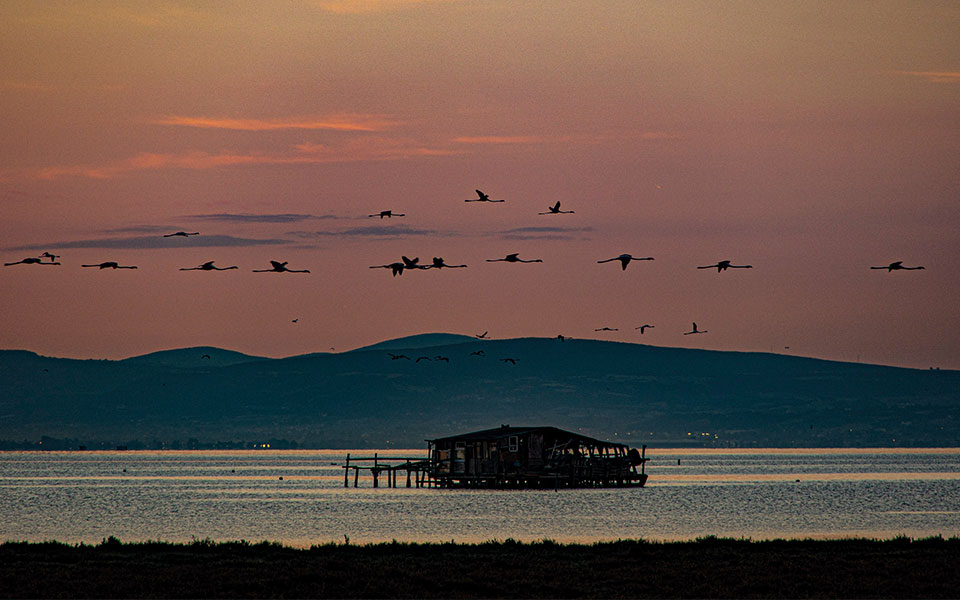If you can break away from Thessaloniki’s urban attractions, even just for a morning or an afternoon, you’ll find delightful destinations within easy reach.
A culture of pleasure joins cultural pleasures; here in the heartland of ancient Macedonia are some of Greece’s most important and impressive archaeological sites and museums. Meanwhile, amid the mountains and beaches, forests and wetlands, there are delights for nature lovers and oenophiles alike. Beneath wide plane trees at village cafés, time slows agreeably. And who doesn’t love a hot spring in the woods?

© Getty Images/Ideal Image
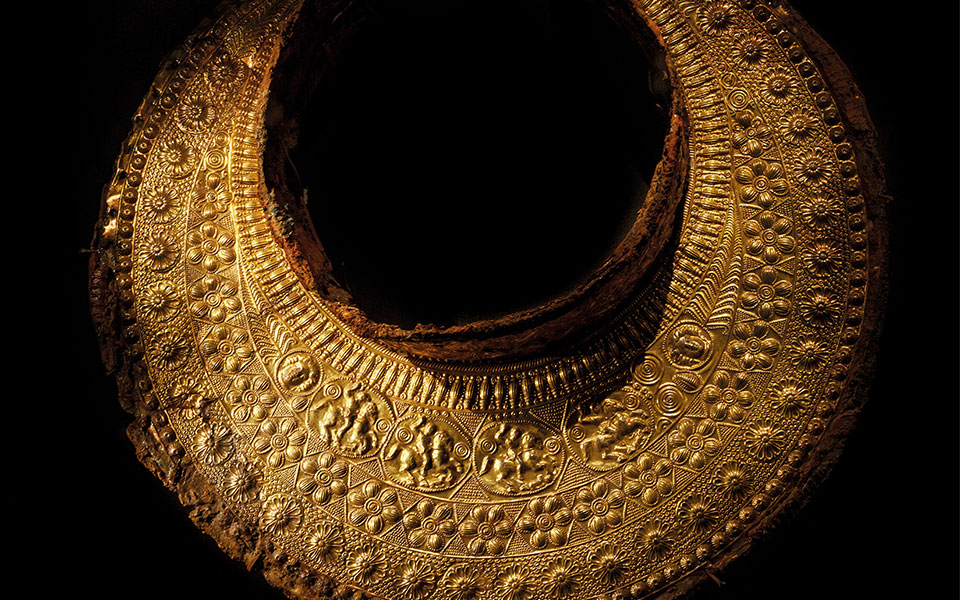
© Visualhellas.gr
In 45 minutes, you can be in an avian paradise, binoculars in hand, at the Nea Agathoupoli bird-watching tower. This protected coastal wetland, abundant in food, is a haven for many species, both local and migratory. Pelicans are here in the warmer months, joining the gorgeous year-round residents; including swans, flamingos and herons. In cooler months, birds from northern territories come to spend the winter here in style; ducks of several different species arrive in thousands, joined by the endangered spotted eagle. December is the peak of activity, but spring brings Greece’s largest colony of gulls. For an up-close look, binoculars and telescopes are at the tower, along with enthusiastic expert guidance. The bird-watching tower is open Wed-Fri (plus two Saturdays a month), from 10:00-14:00. The opening hours mean you’ll likely be here before lunch, which is perfect; the fun can continue just five minutes away at the bird-friendly seaside eatery, Psarotaverna Nikos, serving seasonal fish and other seafood fresh from local waters.
Another half hour brings you to Vergina and the museum and archaeological site of Ancient Aigai, the royal seat of Ancient Macedonia, one of the most profoundly moving experiences of history and culture to be had anywhere. Passing through a narrow entrance into the reconstructed burial mound, you’ll find a unique museum space of reverent semi-darkness, filled with objects of luminous beauty. Chief among them is the golden oak wreath of Phillip II and his elaborate larnax, hammered from over seven kilos of gold. The emotional impact upon seeing the royal tomb of Phillip II, displayed here in situ, may catch you by surprise, as will the poignantly articulate rendering of the abduction of Persephone on another royal tomb. The words of the great archaeologist Manolis Andronikos, displayed as you exit, will fire your imagination.
Info
Axios Delta National Park, Nea Agathoupoli Bird Watching Tower, axiosdelta.gr
Psarotaverna Nikos, Tel. (+30) 23530.515.70
Museum of the Royal Tombs of Aigai, aigai.gr
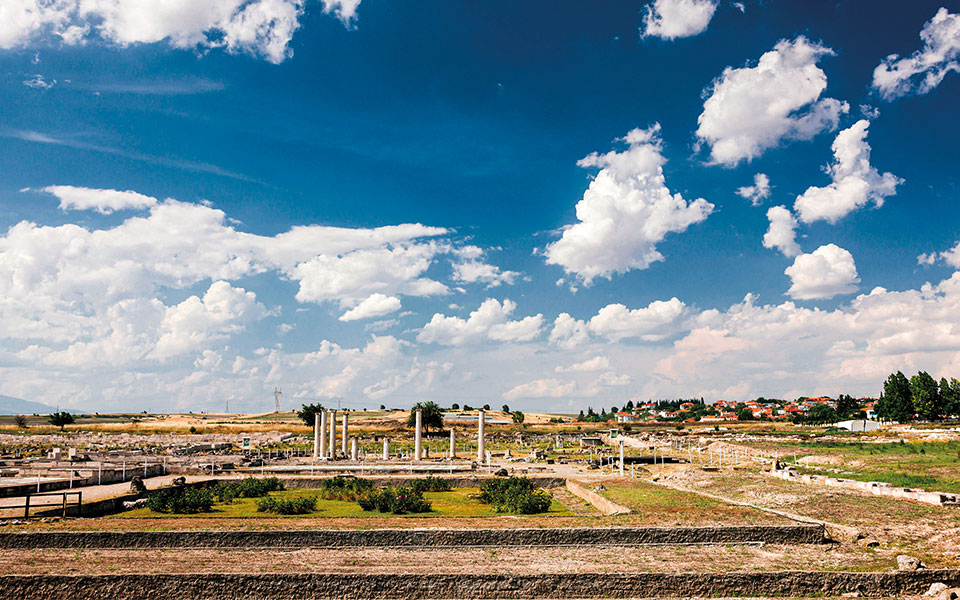
© Visualhellas.gr
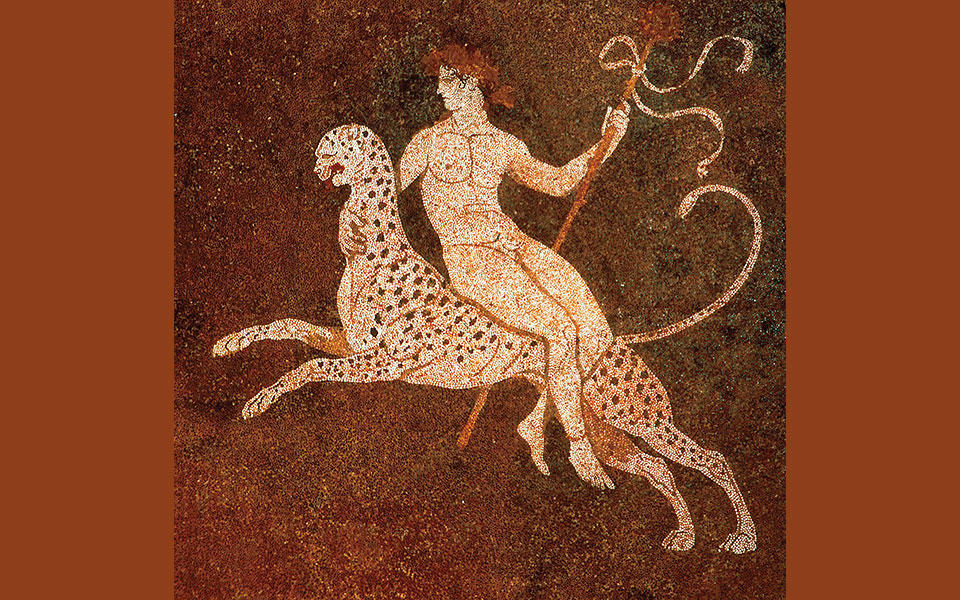
© AFP/Visualhellas.gr
Or, in 45 minutes, you can be at ancient Pella, birthplace of Alexander the Great. Located on the coast in ancient times, Pella replaced Aigai as the capital of Macedonia. The large archaeological park reveals Pella’s elegant Hippodamian urban plan – its sensible grid of streets, a vast agora surrounded by workshops and boutiques, and sumptuous private homes with grand mosaics. It’s easy to imagine what life must have been like here as you wander through the large site. The items in the splendid on-site museum include beautiful artifacts and furnishings that suggest a refined lifestyle. A highlight is a is a fresco on a five-meter-high wall, painted in the First Pompeian style; its trompe l’oeil marble, faux structural elements rendered in plaster, and slice of ‘sky’ at the top convey the ancient city’s grandeur and sophistication.
Half an hour from Pella is Goumenissa, with its friendly town square ringed by plane trees and boasting a fountain flowing with cool mountain water at its center. Goumenissa is in the heart of prime wine country known mainly for the lush and likable reds and rosés of the local grape Negoska. Balancing the Xinomavro (magnificent, if sometimes called “complicated”), Negoska is an essential component of Goumenissa’s nuanced but enormously drinkable PDO red blends. Of the several excellent wineries, biodynamic Domaine Tatsis stands out. The austere building housing the winery is consistent with the company’s philosophy; it’s all substance here. Perikles Tatsis calls himself a viticulturist first and a winemaker second, an approach that serves him well. The “Old Roots” series reveals a deep respect for heritage and for the vine itself. Tatsis rescued many abandoned vines – some a century old – and moved them here. Tended with care, they produce fruit of exceptional character in yields considerably smaller than that of younger vines. Old Roots Xinomavro or Negoska offer a privileged taste of the region’s heritage, while “Pappou” (grandfather) is a blend of all the grapes together: locals call it a taste of childhood.
Info
Museum and archaeological site of Pella, Tel. (+30) 23820.311.60, pella-museum.gr
Domaine Tatsis, Goumenissas-Filirias Road. Tel. (+30) 23430.430.60, ktimatatsis.gr
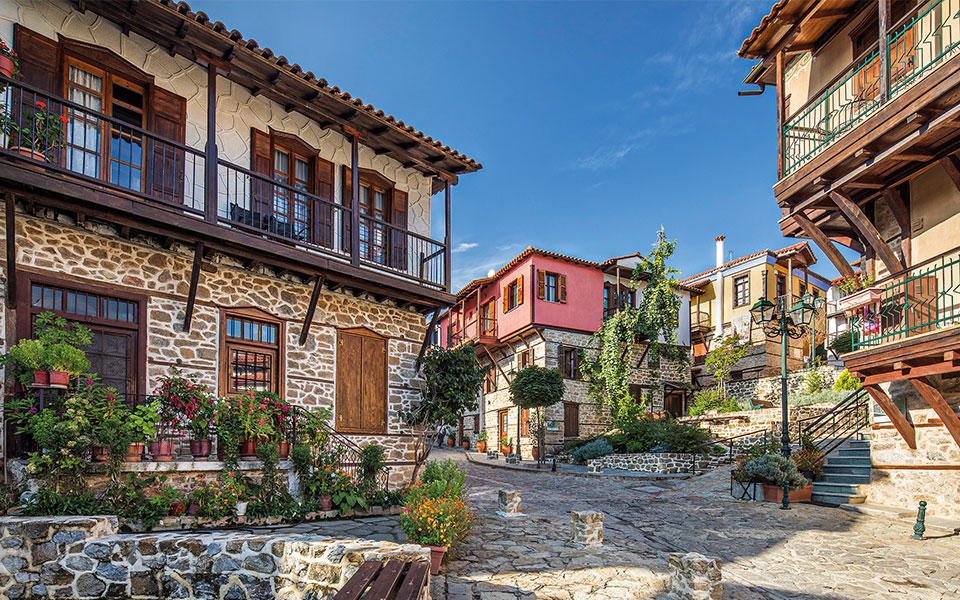
© Visualhellas.gr
In an hour and a half, you can be in Aristotle’s hometown. Somehow, all these glittering beaches have managed to outshine Chalkidiki’s most significant destination; on a lush peninsular headland along a tranquil stretch of the western coast is ancient Stageira, the birthplace of Aristotle (384-322 BC). Stageira is an unusual and exciting archaeological site; wild and green, with minimal intervention and discreet signage, it feels almost untouched. There’s plenty to see, including the walls of the acropolis – so unusual in their complex and polychromatic construction; the ruins of the stoa; the foundations of a grand 6th-century temple; and workshops and homes. It’s thanks to Aristotle himself that there’s much of anything to see; during his long absence from Stageira (he left for the Academy in Athens when he was 17), Phillip II of Macedon all but destroyed the city during his conquest of Chalkidiki. When Aristotle finally returned north two decades later, it was to tutor Phillip’s son, Alexander the Great. In the philosopher’s honor, Phillip restored the city of his birth, and life in Stageira continued.
If the weather’s sunny, one of the seaside tavernas in adjacent Olympiada will do nicely for lunch. Otherwise, plan for a cozy lunch in Arnaia on the way back. This slightly longer lovely route is worth it either way – Arnaia is one of Chalkidiki’s most picturesque mountain villages. Refresh yourself with the water gushing from the plane tree in the square before wandering the cobbled alleys and visiting the 1821 Church of Aghios Stefanos. A fire in 2005 led to reconstruction that revealed magnificent finds from the early Christian era through the 17th century. The older ruins are visible beneath the church’s now-transparent floors. Visits to Arnaia traditionally end on a sweet note; exceptional local pine honey is available at shops around the square.
Info
Ancient Stageira Tel. (+30) 23710.220.60, 2310.285.163
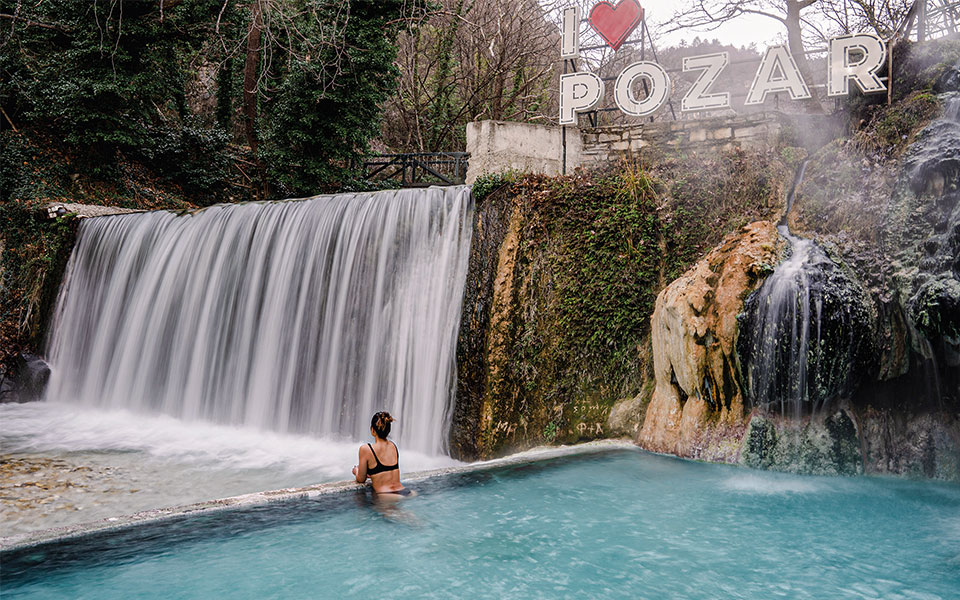
© Nicholas Mastroras
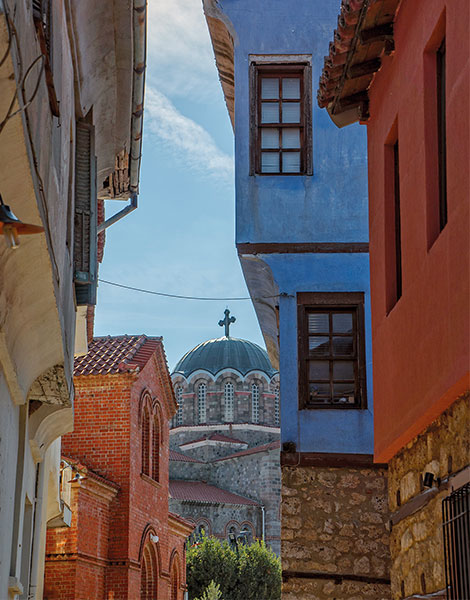
© Perikles Merakos
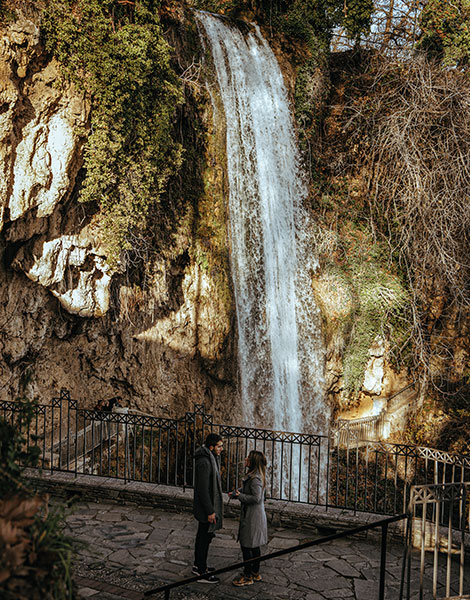
© Olga Deikou
In an hour and a half, you can be at Greece’s largest waterfall. Driving west across the fertile plains of Pella, you’ll eventually spot a cliff rising dramatically in the distance. At the top is charming Edessa, most famous for its fabulous 70-meter Karanos Waterfall. A path brings you behind a great curtain of water, crashing into rocky pools below as it makes its way down to the plains. The rushing water charges the air with negative ions, filling you with energy and optimism. That mood carries on through the town, as the waters of the Edessaios River flow like music through Edessa’s seven canals. Lush banks, tall trees, and 200 bridges, large and small, complete the enchanting townscape. The air must affect the residents too, because they’re delightful: Edessa is a warm and hospitable town, a favorite of Greek visitors who come for good food, dreamy views, and beautiful traditional architecture. In the Varosi quarter at the cliff’s edge, you can visit the Church of the Assumption of the Virgin, with its magnificent late 14th-century frescoes. Because the artworks are fragile, the church is rarely used for services; its bare interior invites contemplation.
There’s more water half an hour away. Steam rises thickly into the trees overhead from Pozar’s thermal springs. Thermal waterfalls fill a natural pool beside more waterfalls and a river. There’s also a large swimming pool and other indoor bathing facilities, including many private baths for small groups.Everything stays open until 21:00, and the outdoor waterfall bath and the private indoor baths stay open until 02:00 (04:00 on Saturdays), making a visit here a popular late-night activity.
Info
Reservations for private baths at Pozar: Tel. (+30) 23840.913.00

